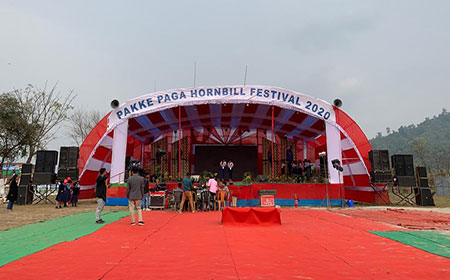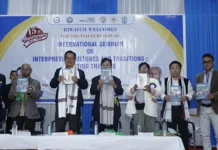[ Amar Sangno ]
Rock music, ‘DJ nights’ and beauty pageants have become part of the ‘recipe’ of every festival in Arunachal. In a way, such events are effective mediums of communication in terms of engaging with the crowd: from teenagers to octogenarians, all love music and merrymaking in Arunachal.
However, sometimes they surreptitiously sidetrack the objective of the festival itself, as has been the case with the Pakke-Paga Hornbill Festival (PPHF).
As the curtains fell on the third edition of the PPHF on Monday evening at Darlong village, in the vicinity of the Pakke Tiger Reserve (PTR) in Pakke-Kessang district, Seijosa town witnessed a high-decibel musical night, packed with a DJ and the mandatory beauty pageant, leaving many unconvinced – bewildered even – by the festival’s much-touted tagline, ‘Celebrating Nature’.
For such people, the tagline was not only paradoxical but also insensitive towards the animals, with the festival’s emphasis being on recreational activities, such as the aforementioned events, along with the hustle and bustle of stalls and selling of drinks and a variety of meats, rather than on offering a raw experience of nature.
God only knows what kinds of meats were on the menus. Activities like jungle safari, elephant safari, birdwatching and ‘silent walks’ had less takers. How can one call a noisy musical night ‘celebrating nature’?
The PPHF is the state’s lone ‘conservation festival’. It was approved by the state wildlife advisory board, under the chairmanship of Chief Minister Pema Khandu, on 26 April, 2018. It had been conceptualized by Aparajita Datta – a scientist from the Nature Conservation Foundation – along with DFO Tana Tapi, with the objective of acknowledging the role of the Nyishi tribe in conserving the endangered hornbill, and their role as conservationists who protect the tigers.
It was also aimed at creating awareness about wildlife and forests among the local people, and to devise alternative sources of income for those who rely on hunting and logging.
The festival was first celebrated from 18-20 January, 2015. The method of celebrating the PPHF drew flak from some quarters as the festival ground is in the vicinity of the PTR, which was awarded the India Biodiversity Award in 2016 in the ‘conservation of threatened species’ category for its hornbill nest adoption programme.
Some critics berated the organising committee for incorporating blaring music, beauty pageants and commercial stalls and using non-biodegradable materials for constructing the pandals, as such activities disturb the sanctity of the wildlife kingdom.
“PPHF cannot be celebrated like any other festival in Arunachal by incorporating blaring music, DJ nights and beauty pageants. It should be a silent research festival, focusing on creating an eco-friendly atmosphere by using biodegradable things,” said a critic who preferred not to be named.
Sound is measured in decibels. Sound sources that exceed this threshold include familiar things, such as power lawnmowers (90 decibels), subway trains (90 to 115 decibels), and loud rock concerts (110 to 120 decibels).
It is scientifically proven that animals use sound for a variety of reasons, including for navigation, finding food, attracting mates, and avoiding predators. Noise pollution makes it difficult for them to accomplish these tasks, which affects their ability to survive. Many birds during courtship with males produce sounds when they are engaged in the mating dance. Blaring music has anthropogenic effects on the wildlife.
A prominent researcher at the Ashoka Trust for Research in Ecology & the Environment, who also requested anonymity, observed, “Some species avoid noisy areas and sometimes this may be the area where they find abundant food, mate or safety for their young ones which they will have to abandon or forego due to loud noise.”
She added: “When noise is combined with other factors, like climatic conditions, lack of food and shelter, breeding space, mate, etc, it can have a very negative impact on the health of the wildlife.”
The organising committee argued that musical nights and beauty contests, rather than conventional panel discussions on issues related to conservation, draw the crowd – more importantly the teenagers, who are attracted by music and glamour.
“Music was incorporated as people need a reason to assemble, or else giving message to a large number of people was impossible. We also try to involve people from neighbouring states like Assam who have equal role in conservation,” said Pakke-Kessang MLA Biyuram Wahge.
After courting criticism, the organising committee this year incorporated a panel discussion on relevant topics, such as sustainable development of the community and building bridges between livelihood options and sustainable use of natural resources, inviting conservationists and naturalists from different parts of India.
Sadly, only a countable number of local people turned up, other than a few students from VKV Seijosa.
“This year we stressed on research-based panel discussion focusing on awareness on human-animal relationship and conflicts,” Wahge said.
“We have also started felicitating the local people who lost their lives in order to protect wild animals, especially the hornbill,” the MLA added.
He informed that the organising committee wanted to celebrate the festival in comparative silence, emphasizing more on conservation and sustainable development, “but the youths involved in the festival were adamant for musical nights, DJ and beauty pageant, saying these elements give the festival extra colour.”
The PPHF is a calendar event of the state’s forest department. It is supported by the tourism department, and is associated with reputed organisations like the World Wildlife Fund, the Nature Conservation Fund, the Wildlife Trust of India, etc.
Needless to say, the festival has the potential to attract naturalists, conservationists, zoologists and wildlife activists from across the globe as the PTR lies in the vicinity of its venue. However, apparently a major portion of the funding goes into recreational activities like hiring artists, rock bands and musical instruments, which are unproductive in a conservation festival.
It is rightly said that conservation without the community is not possible. For the sustenance of the festival, the local community needs to be engaged in conservation efforts and sustainable development. Folktales-telling competitions on human-animal relationship and promotion of hospitality and homestays for sustainable ecotourism should be encouraged.
Engage unemployment youths as nature guides, the way the forest department is doing a commendable job by turning poachers into special task force personnel.
Instead of a three-day festival dominated by blaring music, the festival should be celebrated throughout the month, with research activities and adoption programmes, and silent flag-off and flag-in ceremonies.
Involve NGOs that have been working in the field or on the subject for many years, in order to invigorate and improve the celebration. Promote eco-friendly and nature-based materials for the stage, stalls, seats, etc, besides traditional activities during the festival.
Build more treehouses, and develop longer safari routes, ensuring the safety of tourists and researchers. These are the actual USP of the PPHF. The festival had been started with the right intentions, but it seems like it has lost its way in implementation.





